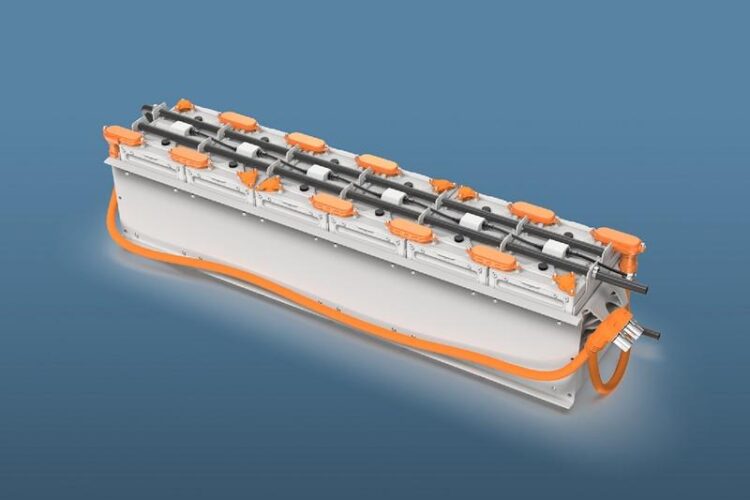LASER World of PHOTONICS 2023: Premiere of the Arctic Kind

The Finnish startup Aurora Powertrains had a customized laser welding system developed at Fraunhofer ILT for its modular, scalable snowmobile battery.
© Aurora Powertrains
An electric snowmobile at LASER World of PHOTONICS 2023 in the summer! Why?
Trade show visitors have the Finnish startup Aurora Powertrains Oy from Rovaniemi to thank for this premiere of the Arctic kind. Aurora has developed cold-resistant batteries with extremely high energy density for the Arctic temperatures of this region, and the customized joining technology required for this comes from the laser welding experts at the Fraunhofer Institute for Laser Technology ILT in Aachen.
Probably one of the smallest and certainly coolest vehicle manufacturers in the world sits high in the Arctic north of Finland. The startup Aurora Powertrains Oy from Rovaniemi has developed the eSled, one of the world’s first electric snowmobiles. The researchers were motivated to bring sustainable mobility to the coldest of climates; not only do the electric snowmobiles emit no CO2, but they make far less noise when travelling through the Arctic landscape. One snowmobile weighs up to 270 kilograms and has a range of 40 to 100 kilometers on a single charge, depending on battery power (energy capacity: 7 to 21 kWh). At more than 190 Wh/kg, the energy density of the self-developed waterproof and dustproof battery with IP67 classification is strikingly high.
End-to-end support: from the idea to large-scale production
The company uses lithium-ion NMC pouch cells with 0.2 mm thin copper and aluminum electrical contacts. Since there was not enough space to efficiently use ultrasonic welding equipment, Aurora Powertrains had a customized laser welding process developed at the Fraunhofer ILT. “We evaluated the idea, manufactured the first samples and supported the Finnish startup in its further development,” explains Dr. Alexander Olowinsky, head of the Joining and Cutting department at Fraunhofer ILT. “Now we are helping them implement the technology for large-scale production.”
The Finnish engineers weld with a single mode 1 kW fiber laser at a wavelength of 1070 nm and a beam width of 30 µm, whose control electronics modulate the power locally. The laser beam is, therefore, not guided in a straight line, but in lines with superimposed circles over the component. “What speaks in favor of power modulation is that we achieve significantly wider weld seams at the same laser power and thus increase electrical conductivity,” explains Sören Hollatz, research associate at Fraunhofer ILT.
Infrared laser welds quickly and effectively
The Aachen-based research institute decided to use a conventional infrared laser for the connection, which is an aluminum cell tab on a copper tab in this case. “Because aluminum is on top, the absorption at green or blue laser wavelengths is not as advantageous as it is with copper. For this reason, we prefer to use an infrared laser with a small beam diameter,” says Sören Hollatz. “The beam quality is currently even worse with green or blue laser systems. The single-mode infrared laser is, therefore, the more elegant, faster and significantly more cost-effective solution.”
The newly designed battery module is already attracting interest from companies in a wide range of industries due to its high energy density and IP67 classification. Basic modules serve as the basis, which the startup links to form a battery via laser-welded plug-in contacts. Because the size and voltage concept can be adapted, the batteries from the Arctic are also suitable for work machines, energy storage systems and larger vehicles.
Scalable battery concept also suitable for electric trucks
“Since the batteries can be scaled, we can even manufacture them for electrically powered trucks and do so without significantly higher costs for the additional technical effort compared to conventional battery modules,” explains Matti Autioniemi proudly, CEO and co-founder of Aurora Powertrains. “Currently we are developing concepts for a Finnish electric boat company and an off-road vehicle whose battery is designed for 120 kWh. In April we have started a new project to develop a concept for special electric watercraft.”
Interested parties can find out details of this Arctic premiere at LASER World of PHOTONICS from June 27 to 30, 2023 in Munich at the Fraunhofer joint booth (Hall A3, Booth 441), where the Finns will present their eSled and the battery concept together with experts from Fraunhofer ILT.
Wissenschaftliche Ansprechpartner:
Sören Hollatz M. Sc.
Group Micro Joining
Telephone +49 241 8906-613
soeren.hollatz@ilt.fraunhofer.de
Dr. Alexander Olowinsky
Head of Joining and Cutting Telephone +49 241 8906-491
alexander.olowinsky@ilt.fraunhofer.de
Fraunhofer Institute for Laser Technology ILT
Steinbachstrasse 15
52074 Aachen, Germany
www.ilt.fraunhofer.de
Weitere Informationen:
Media Contact
All latest news from the category: Power and Electrical Engineering
This topic covers issues related to energy generation, conversion, transportation and consumption and how the industry is addressing the challenge of energy efficiency in general.
innovations-report provides in-depth and informative reports and articles on subjects ranging from wind energy, fuel cell technology, solar energy, geothermal energy, petroleum, gas, nuclear engineering, alternative energy and energy efficiency to fusion, hydrogen and superconductor technologies.
Newest articles

Innovative 3D printed scaffolds offer new hope for bone healing
Researchers at the Institute for Bioengineering of Catalonia have developed novel 3D printed PLA-CaP scaffolds that promote blood vessel formation, ensuring better healing and regeneration of bone tissue. Bone is…

The surprising role of gut infection in Alzheimer’s disease
ASU- and Banner Alzheimer’s Institute-led study implicates link between a common virus and the disease, which travels from the gut to the brain and may be a target for antiviral…

Molecular gardening: New enzymes discovered for protein modification pruning
How deubiquitinases USP53 and USP54 cleave long polyubiquitin chains and how the former is linked to liver disease in children. Deubiquitinases (DUBs) are enzymes used by cells to trim protein…



